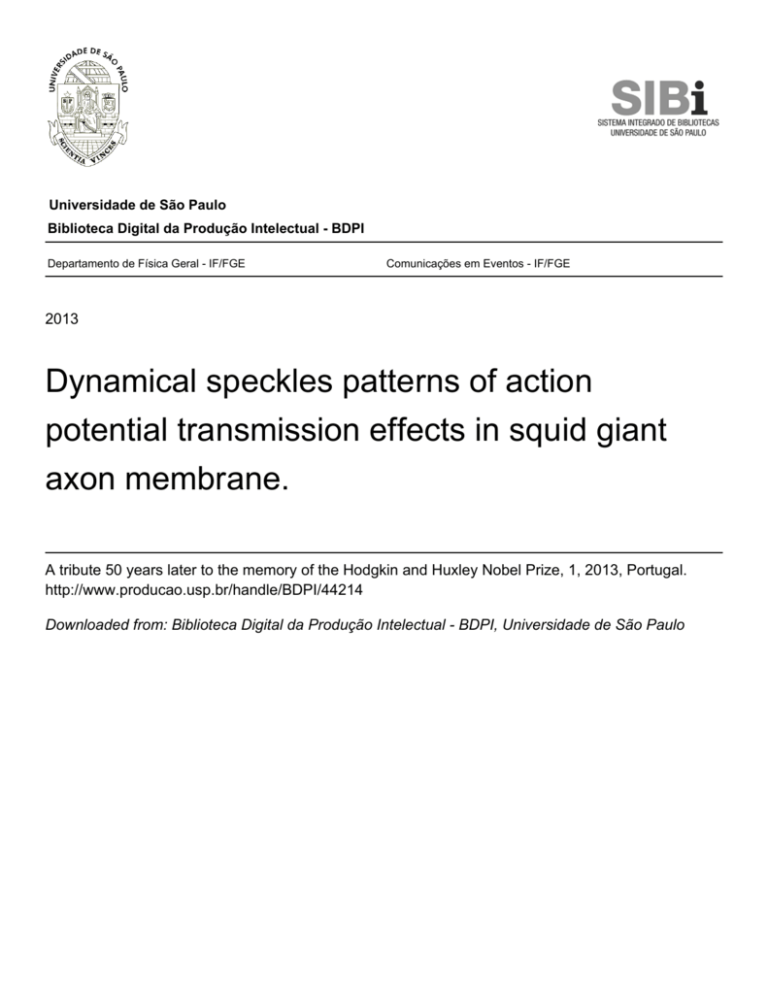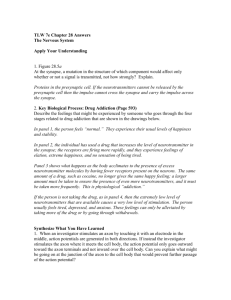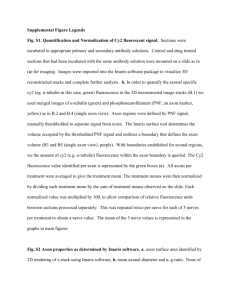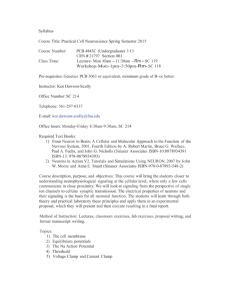Dynamical speckles patterns of action potential transmission effects
advertisement

Universidade de São Paulo
Biblioteca Digital da Produção Intelectual - BDPI
Departamento de Física Geral - IF/FGE
Comunicações em Eventos - IF/FGE
2013
Dynamical speckles patterns of action
potential transmission effects in squid giant
axon membrane.
A tribute 50 years later to the memory of the Hodgkin and Huxley Nobel Prize, 1, 2013, Portugal.
http://www.producao.usp.br/handle/BDPI/44214
Downloaded from: Biblioteca Digital da Produção Intelectual - BDPI, Universidade de São Paulo
Dynamical speckles patterns of action potential transmission effects in
squid giant axon membrane.
A tribute 50 years later to the memory of the Hodgkin and Huxley
Nobel Prize.
Juan J. Llovera-González*a, Alfredo B. Moreno-Yerasa, Mikiya Muramatsub Diogo Sogab
Rolando L. Serra-Toledoa Daniel S. F. Magalhãesc
a
Dept. of Physics, Instituto Superior Politécnico“José Antonio Echeverría”,Calle 114 # 11901
Marianao, La Habana CP 19390, Cuba.
b
Group of Optics and Amorfous Systems, Physics Institute, Universidade de Sao Paulo, Rua do
Matão Travessa R Nro. 187 Cidade Universitària, Sao Paulo CPE 05508-090
c
Laboratório de Neuroimagem, Hospital das Clínicas da Unicamp - 2º andar -Faculdade de
Ciências Médicas - Rua Vital Brasil, 251, CEP -13083-888 Campinas -SP - Brasil
ABSTRACT
Undoubtedly the most important result of the investigations in physiology and biophysics was the discovery of the
electrochemical mechanism of propagation of the action potential in nerves that was made by Hodgkin and Huxley
during the first half of the past century. Since some decades ago diverse experiments about the electro optical properties
of the axon membrane there was published using the most diverse optical experimental procedures6-10. In this paper some
results of a dynamical speckle technique applied for obtaining microscopic images of a section of a squid giant axon
membrane during the activation by electrical impulses and his digital process are presented.
Keywords: Speckle patterns, squid giant axon, H-H theory, action potential, membrane potential, sodium channels.
1. INTRODUCTION
One of the most important results of the investigations in physiology and biophysics was the discovery of the
electrochemical mechanism of propagation of the action potential in nerves made by Hodgkin and Huxley during the
first half of the past century using the giant axon of squid1-5.
Since that moment many investigations were developed in order to reveal the specific mechanism of transmission of the
action potential because this phenomenon is in the base of the nervous transmission in all de life organism and the
success of an optical relation between the birefringence properties of the phospholipid than conform the giant squid axon
and the action potential transmitted was a very interesting success6-10.
The use of speckle patterns techniques has been little reported11 however this technique complemented with digital image
process is a good alternative to study some effects of the action potential in the optical properties of the giant squid axon.
In this paper results of recorded and processed images of the speckle patterns of the giant squid axon activated using
electrical impulses are presented.
8th Iberoamerican Optics Meeting and 11th Latin American Meeting on Optics, Lasers, and Applications,
edited by Manuel Filipe P. C. Martins Costa, Proc. of SPIE Vol. 8785, 8785DH
© 2013 SPIE · CCC code: 0277-786X/13/$18 · doi: 10.1117/12.2026312
Proc. of SPIE Vol. 8785 8785DH-1
Downloaded From: http://spiedigitallibrary.org/ on 01/28/2014 Terms of Use: http://spiedl.org/terms
2. METHODOLOGY
2.1. Experimental design:
In order to observe the giant axon of squid, the speckle pattern technique was implemented. When the laser light was
reflected or transmitted in a non-homogeneous surface a spatial and granular pattern of interference is formed, this is the
speckle pattern12. The experimental system was used as the one that is shown in the figure 1.
microcomputer
CCD
LEICamera
body tube
polarizer
objective
lens
8
sample
speckle
Stage of
microscope
despolished glass plate
objective
laser
lens
V
Fig 1. Experimental setup scheme
A He-Ne laser 632 nm wavelength and 6,0 mW was used. The laser light was expanded by lens and deviated by a mirror.
Then part pass through a polarizer plate and scattered by an unpolished glass plate used to form a speckle pattern that
illuminate the sample mounted over the stage of an optical microscope (OPTICOM, XSZ-107T) with magnification 64
X. The image was captured using a CCD camera with 1027 x 850 pixel and frame rate of 30 fps connected to the
microcomputer. The experimental setup was completed with a signals generator and an oscilloscope in order to produce
and visualize the signal of square pulses used to activate the axon and to see the signal response in the oscilloscope. See
fig. 2 and 3. The polarization direction of the second polarizer, after the objective lens, could be aligned or not to the
polarization direction of the first polarizer.
Fig.2. Two views of the experimental setup.
Proc. of SPIE Vol. 8785 8785DH-2
Downloaded From: http://spiedigitallibrary.org/ on 01/28/2014 Terms of Use: http://spiedl.org/terms
Fig. 3 Giant axon with electrodes in the Petri dish mounted on the plate of the microscope
The giant axon used was extracted by surgery of a big specimen (30 cm long) of squid (loligo saopauliensis) and
imbibed in a saline solution of Na Cl 300 mM in a Petri dish.
In order to process digitally the obtained images some softwares were specifically developed using MATLAB 7.9
(R2009b) (MatWork Inc. USA) and Imagen J for Windows XP (Professional) operational system. And was used the
software Tracker, version 2.54. to process the videos.
2.2. Capture and process of images method.
The axon was stimulated with a signal of square pulse of 75 mV maximal voltage varing the frequency from 20 Hz to
100 Hz.
The process of activation was recorded with the CCD camera that was focused over the surface of the saline solution and
the axon interface is visualized. All videos have 500 frames (≈17 s).
Before the capture of the spreading process an image of the reference speckle pattern obtained in the saline solution at
rest was captured in each case. This reference pattern was subtracted of each frame of the video. Using our software to
modify the format of color RGB to white and black.
To obtain some information about the birefringence properties, the images were registered using crossed polarizers. In
this condition no light is transmitted after the second polarizer, unless that the sample changes the polarization direction
of the transmitted light. This light allows to visualize the displacement of the electrical impulse along the border of the
axon.
Finally each frame was processed using algorithms of the techniques Laser Speckle Contrast Analysis (LASCA) and
11,13
Laser Speckle Temporal Contrast Analysis (LASTCA)
to increase the contrast of image in the border of axon.
3. EXPERIMENTAL DATA
The code colors associated to the figures are the blue corresponds to the lower contrasts and the red one to the biggest
contrast. The giant axon was excited for different conditions and frequencies, the results are presented in the following.
Proc. of SPIE Vol. 8785 8785DH-3
Downloaded From: http://spiedigitallibrary.org/ on 01/28/2014 Terms of Use: http://spiedl.org/terms
Non-crossed polarizers
Crossed polarizers
Original image
I.
{I
-
LASCA processed
-
r
'
444
e
7;:ak
T
.a..r
l' ..li..aT'
:
r,
99
I
_
1 13
r'
r. L -
:
}).
r
Fig. 4. Comparing images of axon border stimulated at the frequency of 20 Hz
Proc. of SPIE Vol. 8785 8785DH-4
Downloaded From: http://spiedigitallibrary.org/ on 01/28/2014 Terms of Use: http://spiedl.org/terms
_
9`.
,
,, _
',;
' y ,{r. 1
'
:'
;
r
r'"I.
ii
r',r
y+.y
.
47.1l
jr,+;(''
3
.!Pt.L.LT..° 1.
jr'.`
.,
LASTCA processed (5 frames)
4. RESULTS AND DISCUSSION.
In fig. 4 the original image of the speckle pattern of the border of axon is well defined and the effect of birefringence in
this border is observed with crossed polarizers. The image processed by LASCA shows good contrast just in the border
and low contrast inside the axon that indicates the electric signal is propagating along the border as in previous
investigations1,3,6 it was demonstrated. On the other hand for the crossed polarizers the border shows the smallest
contrast compared with the external region, probably that in the external vicinity occurred a process of the interchange of
mass between the axon and the saline solution. In the images processed by the technique LASTCA show the change of
contrast when comparing the crossed polarizers case with the other case. In any image the internal side of the axon not
reveals an appreciable optic activity
In the images processed by LASTCA the change of contrast is revealed too comparing the non-crossed polarizers image
with the crossed polarizers images. In any image the internal side of the axon not reveals an appreciable optic activity.
Fig.5. A sequence of images processed by the technique LASTCA of the border of axon activated with a
periodic square pulse of 100 Hz of frequency.
In fig. 5 a sequence of images of the axon activated with a periodic square pulse of 100 Hz of frequency captured with
crossed polarizers and processed by LASTCA is presented. It is possible to observe a slight quasi-periodical change of
the values of the contrast pattern in the center of image. This behavior can have relationship with the rhythm8,9 with
which the action potential is transmitted and it deserves a study of frequency later on.
The figure 6 shows the framework of the software Tracker, at the left is the image and at the rigth at top the graphic of
intensity oscilations in function of the time. In this graphic it is possible to visualize the periodical oscillations of values
of contrast in the center of the border of the axon at the frequency of 20 Hz.
cs®Ie 'yo_
®
>K
K`,
'
I
31%,N
o regione a pt. radlusl=
t .a0 o ,ea-.l-I
® .able
lu en
0,67
0261
0,333
28.025
28.025
28.025
28.025
28.025
28.025
28.025
28.025
28.025
1 758
1 758
1 758
1 758
1 758
64.202
64.022
12758
12 758
12 758
12 758
12 758
12 758
12 758
12 758
12 758
12 758
60.706
62,309
00493-
Fig. 6. Quasi periodical oscilations of intensity pattern in the center of the border of axon
stimulated with a periodic square pulse of 20 Hz of frequency.
Proc. of SPIE Vol. 8785 8785DH-5
Downloaded From: http://spiedigitallibrary.org/ on 01/28/2014 Terms of Use: http://spiedl.org/terms
The results of the images processed digitally reveal the possibilities to use speckle methods to study the dynamics of the
nervous impulse in the axon.
5. CONCLUSIONS.
Using speckle pattern techniques and digital processing of images is possible to obtain some regularities of the
transmission of action potential in the giant axon.
The technique allows visualizing stages and characteristic of the transmission of the action potential process that are not
visible using the traditional optic methods with non-coherent light.
The processed images reveal behaviors according with the literature reported.
ACKNOWLEDGEMENT
The authors thank Isis Vasconcelos de Brito for allowing a part of experimental biological support in the Laboratory of
Optics of the Physics Institute of Sao Paulo University (USP), and to CAPES and FAPESP for financial support.
REFERENCES.
[1] Hodgkin, A.L. and A.F. Huxley, “Action potentials recorded from inside a nerve fiber,” Nature 144, 710-711
(1939).
[2] Hodgkin, A.L. and A.F. Huxley, “Resting and action potentials in single nerve fibers,” J. Physiol. 104, 176-195
(1945).
[3] Hodgkin, A.L. and Huxley A.F., “Currents carried by sodium and potassium ions through the membrane of the
giant axon of Loligo,“ J. Physiol. 116, 449-472 (1952).
[4] Hodgkin, A. and A. Huxley, “A quantitative description of membrane current and its application to conduction
and excitation in nerve,” J. Physiol. 117, 500-544 (1952).
[5] Huxley, A.F., “Looking back on muscle,” In: The Pursuit of Nature. Informal Essays on the History of
Physiology, Cambridge University Press. Cambridge, 23-64 (1977).
[6] Watanabe, A. and Terakawa, S., “Alteration of birefringence signals from squid giant axon by intracellular
perfusion with protease solution,” Biochim. Biophys. Acta 436, 833-842 (1976).
[7] Landowne, D.,“Optical studies of sodium channels,” Biophys. J. 45 (1), 57-59 (1984).
[8] Baylor, S., “Optical studies of excitation-contraction coupling using voltage-sensitive and calcium-sensitive
probes,” Comp Physiol, 355-379 (2011).
[9] Dombeck, D.A., Blanchard-Desce, M. and Webb, W. W., “Optical recording of action potentials with secondharmonic generation microscopy,” J. Neurosci., 24(4), 999-1003 (2004).
[10] Carter, K. M., George, J. S. and Rector, D.M., “Simultaneus birefringence and scattered light measurements
reveal anatomical features in isolated crustacean nerve,” J. Neurosci. Meth. 135 pp. 9-16 (2004).
[11] Draijer, M., Hondebrink, E., van Leeuwen, T. and Steenbergen, W., “Review of laser speckle contrast
techniques for visualizing tissue perfusion,” Lasers Med Sci. 24(4), 639–651 (2009).
[12] Goodman, J. W., [Speckle phenomena in optics. Theory and applications], Roberts and Company Publishers,
Englewood, Colorado, 1-2 (2007).
[13] James, T. W., Ponticorvo, A. and Dunn, A. K., “Efficient Processing of Laser Speckle Contrast Images,”
IEEE T. Med. Imaging, 27 (12), 1728-1738 (2008).
Proc. of SPIE Vol. 8785 8785DH-6
Downloaded From: http://spiedigitallibrary.org/ on 01/28/2014 Terms of Use: http://spiedl.org/terms








